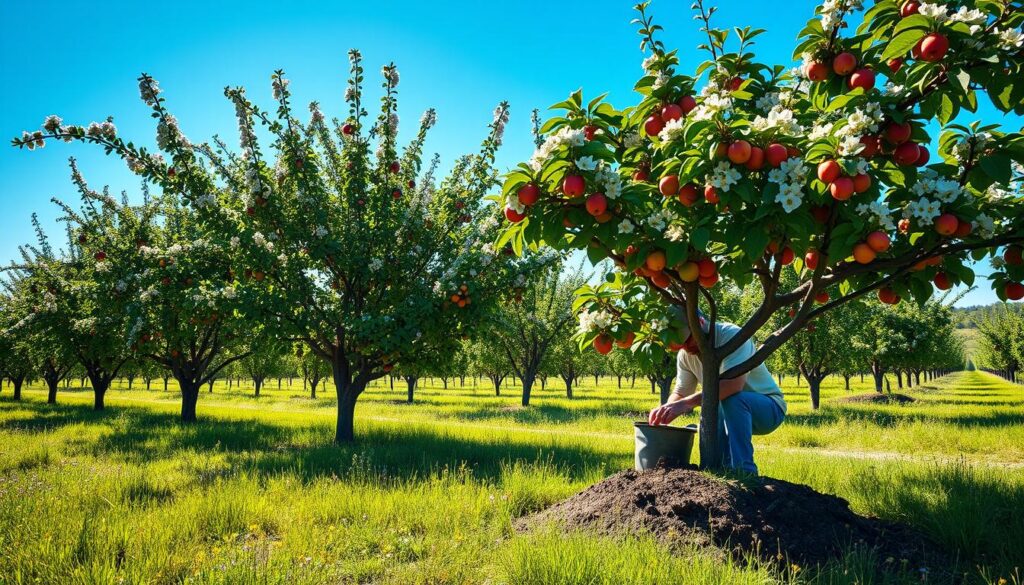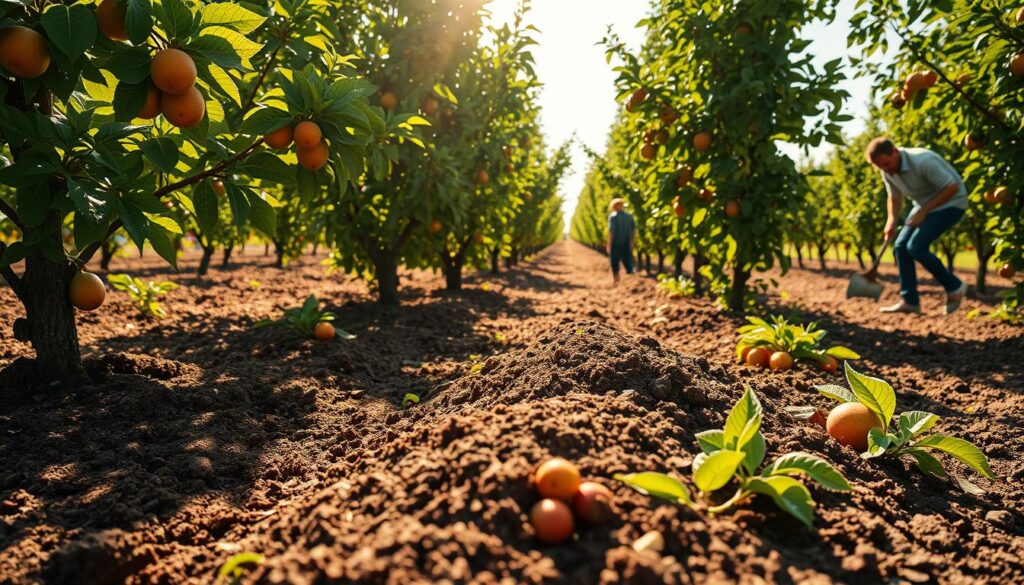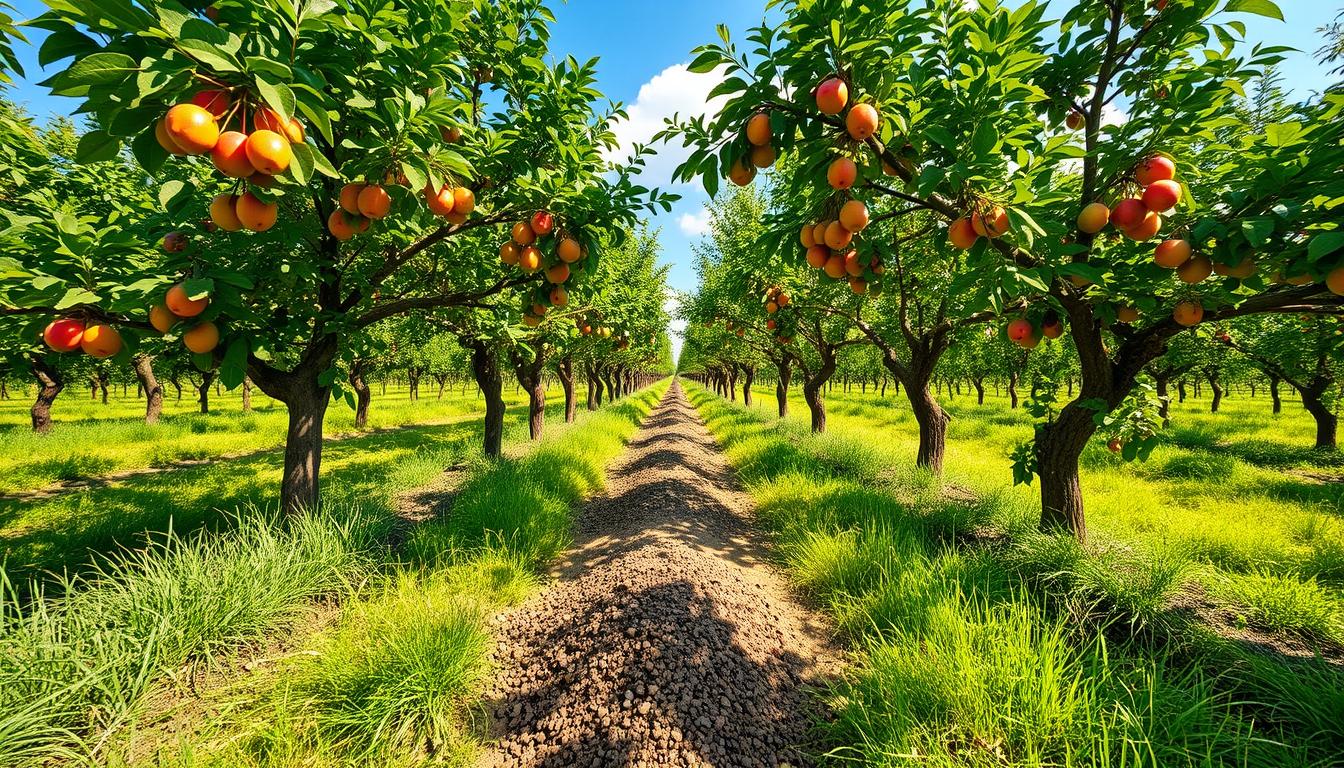Exploring gardening, I see how organic fertilizers boost fruit tree growth and productivity. Fruit trees need lots of nutrients from the soil. The best organic fertilizers feed the plants and keep the ecosystem healthy by avoiding harmful chemicals.
Using eco-friendly fertilizers, I make sure my trees get the nutrients they need. This includes nitrogen, phosphorus, and potassium (NPK), and minerals like calcium and magnesium. Whether I’m caring for young apple trees or bigger ones like pears and stone fruits, the right fertilizer is key. For beginners, GardenBeginner.com is a great resource for guides and advice.
In this article, we’ll look at different organic fertilizers, their nutrients, and how to use them for growing fruit trees. Let’s make our gardens flourish with the best organic fertilizers for fruit trees.
Key Takeaways
- Organic fertilizers are essential for maximizing fruit yield in fruit trees.
- Fruits trees require a balanced diet consisting of essential macronutrients and other minerals.
- Using the correct fertilization techniques promotes healthy vegetative growth.
- Soil testing can identify nutrient deficiencies and guide fertilizer selection.
- Regular application of organic fertilizers helps develop strong root systems in young trees.
Importance of Fertilization for Fruit Trees
Fertilization is key for fruit trees to grow well and produce more fruit. Young trees need a balanced diet to grow strong roots and branches. For older trees, the right fertilization keeps them healthy and productive.
Using organic fertilizers can really help fruit trees stay healthy. Slow-release fertilizers feed trees all season long. Regular soil tests help find and fix any nutrient gaps.
For example, enough calcium can stop fruit from falling off and make it better. A good fertilization plan helps trees grow well, even when it’s hard.
Fruit trees like peaches and nectarines grow a lot when they’re young. But older trees grow less. Knowing how much they grow helps figure out what nutrients they need.
When fertilizing, remember how much nitrogen young trees need. They need 0.10 pounds of nitrogen for each year of age, up to 1 pound. Organic fertilizers like blood meal and soybean meal have different amounts of nitrogen.
Using organic fertilizers like Jobe’s® Organic All-Purpose Fertilizer is very beneficial. It gives trees the nutrients they need all season. This helps trees produce more fruit and stay healthy for a long time.
For more tips on when and how to fertilize fruit trees, check out this useful resource.
Understanding Organic Fertilizers
Organic fertilizers are key for growing fruit trees. They give nutrients slowly, unlike synthetic ones that work fast. This slow release helps soil health and supports plant life.
Natural fruit tree fertilizers have more nutrients than chemical ones. They include important nutrients like calcium and magnesium. For example, rock dust improves soil and adds minerals.
Biological organic fertilizers, made from living things, give trees nutrients right away. Seed meals, seaweed, and fish are great examples. Even ocean water can be used as fertilizer.
When picking sustainable fertilizers for fruit trees, test the soil first. This makes sure the soil gets the right nutrients. Using too much can harm organic gardening. So, choose fertilizers marked “OMRI Listed” for organic use.
I think organic fertilizers are best for long-term soil health. They help soil structure and support biodiversity. This makes a great place for fruit trees to grow.
Best Fertilizers for Growing Fruit Trees Organically
Fertilizing fruit trees organically is key for strong growth and a big harvest. The right fertilizers make a big difference in tree health. Here, I look at the top organic fertilizers for fruit trees, focusing on their nutrients and benefits.
Top Organic Fertilizer Types
My top picks for organic fertilizers are:
- Blood Meal: N-P-K ratio of 13.25-1-0.6. It’s a top choice for high organic nitrogen, great for growth.
- Soybean Meal: N-P-K ratio of 7-2-0. It gives trees the nitrogen, phosphorus, and calcium they need for healthy fruiting.
- Composted Chicken Manure: Rich in nitrogen and micronutrients, it supports balanced growth.
- Cottonseed Meal: N-P-K ratio of 6-0-4. It helps beneficial bacteria in the soil and manages soil acidity.
- Feather Meal: N-P-K ratio of 13-0-0. A slow-release nitrogen source from keratin protein.
- Alfalfa Meal: N-P-K ratio of 3-2-3. A slow-release option with a balanced nutrient profile.
- Bone Meal: N-P-K ratio of 3-15-0. Essential for root, bloom, and fruit production.
- Greensand: N-P-K ratio of 0-0-3. Adds potassium and conditions the soil.
Nutrient Composition and Benefits
When picking the best organic fertilizers for fruit trees, I look at the N-P-K ratios. This ensures a balanced nutrient mix. Each fertilizer has its own benefits, helping growth and preventing nutrient burnout.
| Fertilizer Type | N-P-K Ratio | Benefits |
|---|---|---|
| Blood Meal | 13.25-1-0.6 | High nitrogen source helps promote leaf growth. |
| Soybean Meal | 7-2-0 | Rich in nutrients, supports fruit and flower development. |
| Composted Chicken Manure | Varies | Balanced nutrient content; improves soil structure. |
| Cottonseed Meal | 6-0-4 | Aids beneficial bacteria; helps maintain soil pH. |
| Feather Meal | 13-0-0 | Slow-release nitrogen for prolonged feeding. |
| Alfalfa Meal | 3-2-3 | Encourages healthy root development with balanced nutrients. |
| Bone Meal | 3-15-0 | Vital for strong root growth and overall health. |
| Greensand | 0-0-3 | Source of potassium; improves soil fertility. |
Through my experience, I see how these natural fertilizers help fruit trees grow well. Knowing their nutrient profiles helps me care for my trees effectively.
Types of Organic Fertilizers
Understanding the types of organic fertilizers is key to growing fruit trees well. The choice between slow-release and quick-release fertilizers is crucial. Each type meets different needs of fruit trees.
Slow-Release vs. Quick-Release Fertilizers
Slow-release fertilizers give nutrients slowly, helping trees grow steadily. They prevent over-fertilization and match the tree’s needs. Quick-release fertilizers, on the other hand, provide nutrients right away. They’re great for young trees to grow strong roots fast.
Common Organic Fertilizers for Fruit Trees
Here’s a list of organic fertilizers good for fruit trees. They include what nutrients they have and how to use them:
| Organic Fertilizer | N-P-K Ratio | Benefits | Ideal Usage |
|---|---|---|---|
| Blood Meal | 13.25-1-0.6 | High nitrogen source | For vigorous growth |
| Soybean Meal | 7-2-0 | Provides nitrogen and calcium | Boosts vegetative growth |
| Cottonseed Meal | 6-0-4 | Good nitrogen source, improves soil | For enhanced soil health |
| Feather Meal | 13-0-0 | Slow-release nitrogen | For long-term growth |
| Alfalfa Meal | 3-2-3 | Slow-release nitrogen and nutrients | To improve fruit flavor |
| Bone Meal | 3-15-0 | Essential phosphorus for root and bloom | Stimulates flowering and fruiting |
| Greensand | 0-0-3 | Potassium source, soil conditioner | For nutrient retention |
Choosing the Right Fertilizer for Your Fruit Trees
Choosing the right fertilizer for fruit trees is key to their health and high yields. When choosing organic fertilizers, I look at soil type, tree age, and nutrient needs. This helps me pick the best fertilizer for different fruit trees.
Soil testing is crucial. It shows if the soil lacks calcium or needs more phosphorus and potassium. Different trees like apples, peaches, and plums grow at different rates and need different fertilizers. Young apple trees, for example, do well with organic fertilizers that help their roots grow strong.
For nutrients, I use blood meal, soybean meal, and composted chicken manure. They are great for supporting tree growth without the dangers of too much nitrogen. This makes them ideal for selecting the right fertilizer for fruit trees.
The N-P-K ratios of these fertilizers guide my choices:
| Fertilizer Type | N-P-K Ratio |
|---|---|
| Blood Meal | 13.25-1-0.6 |
| Soybean Meal | 7-2-0 |
| Cottonseed Meal | 6-0-4 |
| Feather Meal | 13-0-0 |
| Bone Meal | 3-15-0 |
| Greensand | 0-0-3 |
Young trees need about 0.10 pounds of nitrogen per year or per inch of trunk diameter. This ensures they get the right amount of fertilizer. Applying fertilizers in the fall helps with root growth and prepares trees for the next growing season.
Understanding these factors helps me make the best choices for organic fertilizers. For more advice, I suggest using a contact page to ask questions and get help with fertilization.
When to Fertilize Your Fruit Trees
Timing is key when fertilizing fruit trees. Knowing when to fertilize can greatly affect their growth and fruit production. Early spring is the best time, especially before buds start growing. This lets the trees use the nutrients during their most important growth phase.
It’s important to consider each tree’s specific needs when planning fertilization. For example, new fruit trees should get fertilized right after they bud. This should finish by July. But, fertilizing too close to fall can stress the trees. So, it’s best to stop fertilizing after July to prevent excessive growth in winter.
Keeping an eye on how your tree grows is also crucial. Measuring growth each year helps you understand what nutrients it needs. For example, peach and nectarine trees grow 18 to 24 inches a year. Apples and pears grow 12 to 18 inches. Knowing these growth rates helps you adjust fertilization to keep your tree healthy and productive.

How to Measure Growth for Fertilization Needs
It’s key to know how to measure fruit tree growth to figure out what fertilizers they need. By looking at growth rings, I can make a fertilization plan that helps my trees stay healthy and produce lots of fruit.
Understanding Growth Rings
Growth rings are important for checking a tree’s health and growth speed. Each ring shows a year’s growth and tells us about the tree’s nutrient and water use. The width and density of these rings show how well a tree has done.
For example, wider rings mean better growing conditions. This might mean the tree got enough fertilizer at the right times.
Measuring Tree Growth
To measure tree growth, I take measurements from different branches to find an average. Each branch grows differently based on sunlight, soil, and competition. I track the vertical and horizontal growth, noting the height and base circumference.
This data lets me compare my trees to what’s expected for their species. It helps me adjust my fertilization plan to boost growth and fruit production.
Calculating the Right Amount of Fertilizer
Proper fertilization is key for fruit trees to grow well and produce fruit. I consider the tree’s age and size when figuring out how much fertilizer it needs. Different fruit trees, like peaches and apples, need different amounts of nutrients.
Factors Influencing Fertilizer Application
Many things affect how much fertilizer a tree needs. These include:
- Soil conditions: Testing the soil helps know what nutrients are missing.
- Previous year’s performance: Checking last year’s growth helps adjust fertilizer plans.
- Tree age and size: Young and old trees need different amounts of nutrients.
- Type of organic fertilizer: Different fertilizers, like blood meal, have different benefits.
- Application timing: Fertilizing at the right time helps trees absorb nutrients better.
By looking at these factors, I can make sure my fruit trees get the right amount of fertilizer. This helps them grow healthy and produce well. You can learn more about calculating fertilizer application for your trees.
| Fertilizer Type | N-P-K Ratio | Primary Benefit |
|---|---|---|
| Blood Meal | 13.25-1-0.6 | High nitrogen source for lush growth |
| Soybean Meal | 7-2-0 | Rich in nitrogen, phosphorus, and calcium |
| Cottonseed Meal | 6-0-4 | Aids beneficial bacteria formation |
| Feather Meal | 13-0-0 | Slower nitrogen release for sustained growth |
| Bone Meal | 3-15-0 | Essential phosphorus for soil enrichment |
Understanding these points helps me make informed choices about fertilizer for my fruit trees.
Applying Fertilizer Effectively
To get the best results in my orchard, I focus on effective fertilizer application. I place fertilizers around the base of each tree to help them grow. I start by spreading organic fertilizers from the trunk to the drip line.
It’s important to know what each fruit tree needs. Young apple trees grow 18-30 inches, while mature pear trees grow 12-18 inches. I make sure my applying organic fertilizers matches these growth rates. This helps the trees grow strong and healthy.

When deciding how much fertilizer to use, I follow a simple rule. Trees need 0.10 pounds of actual nitrogen for every year of age or inch of trunk diameter. I don’t use more than 1 pound of actual nitrogen a year to avoid harming the tree. For trees like plums and sweet cherries, keeping nutrient levels right is key for healthy growth.
| Fertilizer Type | N-P-K Value | Use |
|---|---|---|
| Blood Meal | 13.25-1-0.6 | High organic nitrogen source |
| Soybean Meal | 7-2-0 | High-nitrogen fertilizer |
| Cottonseed Meal | 6-0-4 | Supports beneficial bacteria formation |
| Bone Meal | 3-15-0 | Essential phosphorus source |
Timing is key when fertilizing. I fertilize between late February and July 1. I avoid fertilizing after July 1 to prevent weakening the tree. I also watch how much of the tree’s canopy I prune. If more than 20% is pruned, I wait to fertilize until the tree can recover.
Finally, applying organic fertilizers well means using the right timing, type, and placement. This mix helps the tree grow strong and prepares it for the next fruiting season.
Conclusion
Using the best organic fertilizers is key for my fruit trees to grow well. Options like chicken manure and compost help them grow strong and produce more fruit. This way, I avoid the problems that come with too much nitrogen.
Organic fertilizers do more than just help my trees grow. They also make my garden a healthier place. This is good for both my trees and the environment.
When I apply these fertilizers at the right time, it makes a big difference. Early spring is especially important. Quick-release fertilizers give a quick boost, while slow-release ones feed my trees all season long.
This careful planning helps my trees stay healthy and productive for a long time. It’s good for them and for the planet.
Also, checking my soil regularly helps keep it full of nutrients. This makes my fruit even better and more plentiful. By choosing organic fertilizers, I’m not just helping my orchard. I’m also making sure gardening stays sustainable for years to come.



Leave a Reply